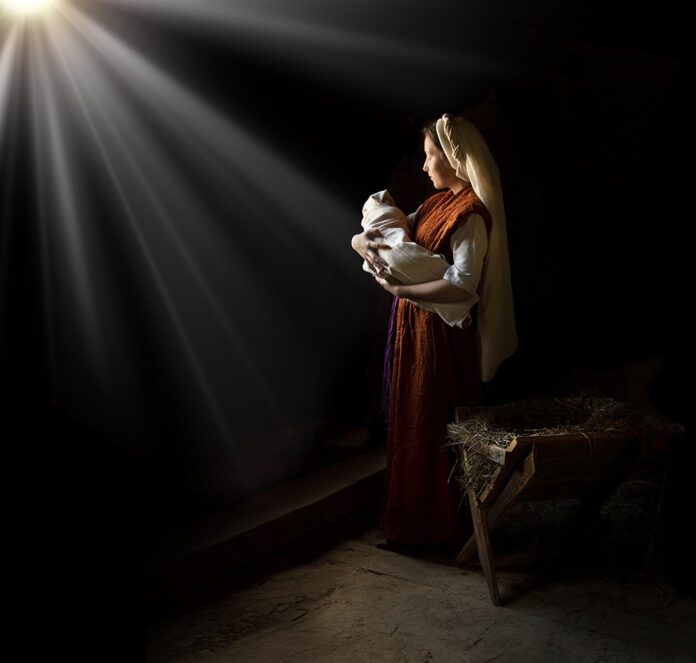This article is part three in a series reflecting on the Joyful Mysteries from a mother’s perspective. You can find part one on the Annunciation here and part two on the Visitation here.
When I was pregnant with my firstborn, I spent hours poring over articles about natural childbirth and birth plans. I packed for the hospital at thirty-six weeks, my folder of typed labor and birth directives tucked safely away. After over twenty-four hours of labor and a baby in distress, however, the last thing on my mind was my labor playlist; one epidural and a vacuum extraction later, my baby girl was born. The months of praying, worrying, and wondering about how labor and delivery would go passed, in hindsight, in the blink of an eye; a healthy baby in hand, my plans for a quiet, natural childbirth no longer seemed important as I wrestled with the new joys and challenges in front of me.
The Bible doesn’t mention Mary’s birth checklist, but I have to imagine that “away from home” and “near animal poop” would not have been on it. In fact, Luke’s telling of the birth of Jesus is pretty sparse: “And while they were there, the time came for her to be delivered. And she gave birth to her first-born son and wrapped him in swaddling cloths, and laid him in a manger, because there was no place for them in the inn” (Luke 2:6–7). (Matthew’s account is even shorter; Mark and John do not mention Jesus’s birth at all.) The events surrounding the birth of Christ—His virgin conception, the shepherds and angels, and the Wise Men—figure much more prominently than the birth itself.
What I think is telling about the simplicity of the birth of Christ (despite the fact that Mary probably had a wild tale to tell what she got back home) is how Mary’s humility is so clearly seen. Our Lady sees herself as merely a player in God’s bigger plan. In the moment, Mary “kept all these things, pondering them in her heart” (Luke 2:19), perhaps wondering if or why all of the inconveniences were necessary. But the generations of Christians who would hear the Nativity’s retelling can so clearly see God’s hand in all of it—the fulfillment of Old Testament prophecies, the emphasis on Jesus’s humble beginnings, the connections to His eventual death.
I would like to imagine that the very human Mary would have had some ideas about how her childbirth experience would go. Maybe she even consulted with other moms to get some pointers. But I also have to believe that, based on her radical trust at the Annunciation, she also was open to God’s plan for bringing this Child into the world. Ultimately, by yielding all of these seemingly undesirable circumstances to God’s plan, Mary allowed His glory to be worked through her.
For moms who, I’m guessing based on your access to the Internet, are not giving birth in stables (though I do know a few who have given birth in cars), we can wonder . . . How do we take Mary’s simple approach to her childbirth experience and apply it to our lives? I see in Our Lady not just a refusal to overwork or overplan as an attempt to grasp at control (like I do), but a total humility in recognizing that her role is to bring about God’s glory, to be His hands and feet.
Whether I am preoccupying myself with the birth of a baby or even just planning a vacation or a child’s birthday party, I can find myself so caught up in the details—worrying about the weather, fixating on the amount of food or snacks, allowing myself to be haunted at night by the fear of something going wrong. Instead of seeing myself as the planner of the event—or the birther of the baby—shifting my focus to a more passive role in God’s greater plan may allow me to also pass on the responsibility, as well as the fear, to Him.
For example, I can tell myself, “I am not planning a birthday party; I am celebrating the child that God has blessed me with. How can I honor His gift and help my kid and those who love him/her to be grateful for this life?”
“I am not hosting a dinner; I am bringing God’s joy and love to others and celebrating the friendship and community I have been blessed with. How can I make the guests feel God’s love for them through me?”
Or on a smaller scale, “I am not washing my dishes; I am remembering in gratitude the food the Lord has blessed us with. How can I offer my gifts to keep my kitchen tidy and ready for the next meal we will be blessed with?”
Simply put, Mary saw herself as a vessel for God’s plan. In turn, Catholics in particular have honored her for her humility, a humility that did not grasp at control but allowed the joys and sufferings to come in order to bring about our Savior. We can try to emulate Mary not just in childbirth but in all facets of our lives in order to bring Christ to the world. Not only would we be filled with more love, but hopefully, the fear of failure or desperation to control can be handed over to God, too.

